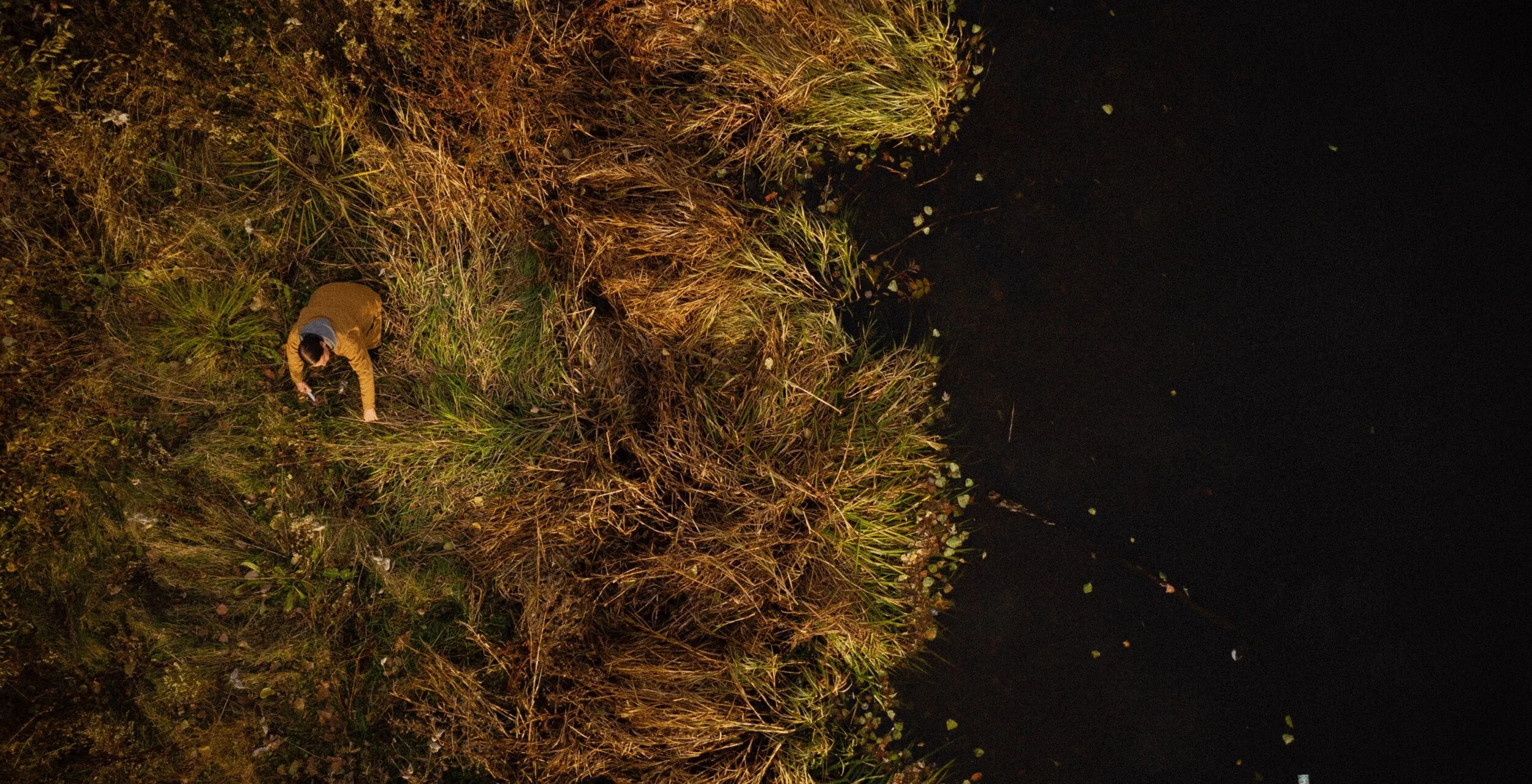Sean Sherman is foraging ancestral knowledge to decolonize cuisine and culture
By Steve Marsh
Photographs by Bill Phelps
The Great Northern partnered with food culture publication Meal Magazine on their second print issue, now available to order. Here we share with you a Great Northern-commissioned article by Steve Marsh on Sean Sherman (chef and author of The Sioux Chef’s Indigenous Kitchen, winner of the 2018 James Beard Award for Best American Cookbook), who is leading a revitalization of Native American foodways and cuisine here in the North and beyond. The story profiles Sherman’s life and vision, along with his dedication to resurrecting knowledge of Native ingredients, foraging, wild food harvesting, and wintertime preservation—and how he brings those practices to the reality of operating a modern-day restaurant.

”This is a nice little slice of what Minnesota should look like,” Sean Sherman says over his shoulder. We are passing through a fenced-in wetland—the wildest land left in Minneapolis—in its full midsummer languor. “This is all wild ginger,” he says, gesturing toward a colony of green, heart-shaped leaves covering the ground just off the well-manicured path. “It’s really strong,” he says, “so you don’t need to use a lot of it.”
I’m already starting to sweat in the humidity of what will become a scorching mid-July day, but I can still feel the cool damp clinging to the ferns unfurling beneath the oaks and tamaracks. It’s great to be back in the Eloise Butler Wildflower Garden. The spring wave of Covid-19 delayed the garden’s opening by almost two months, and there are reminders that things are still extremely weird outside its gate: the path is newly marked as a one-way, and all the park benches are taped off like miniature crime scenes. Yet the vegetation is teeming more or less exactly the way it teemed a century ago, before many of the native plants in this area were tilled over into the undulating fairways of the big golf course next door—not too long after the state violently exiled the Native Dakota inhabitants to reservations out on the plains.
The Wildflower Garden is named for the white schoolteacher and amateur botanist who preserved this refuge back in 1907, ensuring that a pocket of aboriginal plants remained to welcome back the occasional surviving Native—like the guy a couple steps ahead of me.
Sherman is a sturdily built, very chill Lakota dude in his mid-40s, gracefully padding through the garden in Tevas, jeans, and a faded Velvet Underground t-shirt. His hair is parted, plaited into two braids that brush his shoulders. We pass by a gooseberry bush. “Gooseberries are so good,” he marvels. “They’re a cool fruit because they’re tart and juicy with big berries.” He cooks with them by drying them out or making a sauce. “Just simple,” he says. “Reduce them down to a jelly. And we don’t add sugar, because we’ve cut all that out.”

It’s still early enough that we’re the only two visitors. The gate was locked when I showed up, and after a slight panic, I convinced the young docent in the cabin to let us in an hour early: she acquiesced, sufficiently impressed that I was profiling the celebrated Sioux Chef. Over the last five years, Sherman’s moniker, a clever culinary pun, has become a wildly successful brand. First it was the calling card for his catering operation, then his persona as an in-demand lecturer on the global circuit, and finally the title of his James Beard Award-winning cookbook. Now, Sherman as the Sioux Chef is the frontman of an 18-employee business, with non- and for-profit wings lifting his team toward an ambitious goal: the decolonization of the U.S. food industry.
2020 was always going to be a watershed year for that mission, but Sherman’s plans have been forced to adapt to its ruthless volatility. More than two decades into a career mostly spent managing somebody else’s kitchen, Sherman is set to finally open his own restaurant, Owamni, in the Water Works building. A spectacular, $21 million architecturally-salvaged gem designed in partnership with the Minneapolis Park Board, the site has dramatic windows looking out on a sacred Dakota waterfall on the banks of the so-called Mississippi River (Sherman’s Dakota ancestors knew the river as Hahawakpa, roughly translated as “the river of the falls”). Slated to open in spring 2021, Owamni will be his cookbook manifesto come to life, a showcase destination for decolonized cuisine. And, in Sherman’s estimation, an even more important project will be this fall’s opening of the Indigenous Food Lab, a think tank and training center intended to develop a new generation of Indigenous food creatives. But then 2020 happened, and now his plans are as uncertain as everybody else’s.
By midsummer, the suffering of Minneapolis’ homeless and food insecure populations had never been more acute (or apparent). So, funded by a donation from local medical device giant Medtronic, and in partnership with Minnesota Central Kitchen (a group of caterers supporting social justice), Sherman pivoted his entire Sioux Chef catering operation. It became a grain bowl kitchen, pumping out hundreds of healthy meals a day for communities struggling with food insecurity. In ways nothing else could, Sherman says, the pandemic has revealed the urgent necessity of decolonizing our foodways.
We’re on a boardwalk now, crossing the Wildflower Garden’s lowest point, with a thicket of brown cattails shooting out of the water. Sherman, ever the cool professor, points out that the entire spike is edible. “It’s best when you get it early,” he continues. “Like from late spring until right about now.” He says you can peel away layers, like a leek, and then eat the fatty center. “Tastes like cucumber,” he says. He looks at the wood underneath our feet. “But there’s usually no boardwalk to get out to the cattails,” he says. “They’re a swampy plant and harvesting them takes some effort.”
Sherman looks out over the swamp. “More gooseberries here,” he says, “or maybe they’re currants.” He learned how to identify plants in his first job out of high school, with the U.S. Forest Service. “I was a field surveyor,” he says. “And my job was to learn all the plants in the Northern Black Hills.” He would be given an aerial photograph before heading out in a truck to find plot points for his survey. “I would take an eleven-foot radius and record everything in that circle.” Sherman learned all the plant names, and he would determine the ages of the saplings and write everything down in a little black book. Over the years, he’s built up his mental database, which he now supplements with an iPhone app called Picture This.
“It’s pretty cool,” he says. He points his phone’s camera at a leafy plant with little white flowers, and we wait a second. “Bloodroot,” he says. “Huh.”

But what he’d really like to see is signs with Dakota names for the plants, listed above the flora’s common English and Latin names.
Sherman chuckles. “I always joke that if you’re gonna live here, you might as well learn the language.” Sherman believes the nameplates would normalize the Native tongue of our region. And he also points out that to the Dakota, the plant names are just as much about narrative as classification, and isn’t that a more interesting way to catalog knowledge anyway? “For Indigenous, these plants carry stories,” he says. “These plants carry legends. Some of these plants are deities, some of them have spirit, you know?”
It doesn’t take long to realize that Sherman’s vision is far more ambitious than having park board docents stick trilingual placards in the Wildflower Garden.
“It’s not just about understanding wild plants and foraging,” Sherman impresses upon me. “That’s a very small portion of what this is about. It’s more about understanding how Indigenous peoples had a blueprint to live sustainably, utilizing the world around them.”
Sherman believes that cities all over the country should set aside many more areas like this one, and that they should make one big change: urban nature reserves should be places where people cultivate wild plants and harvest them in a sustainable way.
“This is more like a museum,” he reflects, “where you see all this beautiful stuff, but you don’t get to use any of it.” He sees a network of gardens like the Eloise Butler Wildflower Garden, constantly pushing out food and medicine. Sherman notes that many of these plants thrive with human interaction. “You could have areas like this where people come in and harvest for the community.”

He believes that we have yet to grasp what we could do with our landscape—that for too long, our attitude toward nature has been one of extractive exchange. “The model is you can eat if you have money, but it doesn’t have to be like that,” he insists. “With this one little garden here, you could create a huge pantry with all the food you would harvest and preserve and put away.” Sherman sees us building more gardens of every size for shared use, with much greater plant diversity than the monocultural farms that grow our food now.
At this point I’m really getting Sherman’s appeal—why his vision has connected with so many people, why he gets so much ink in the New York Times and airplay on NPR, why TED is just the most recent media entity to eagerly shine its spotlight on him, and why he’s become a renowned chef without having opened his own restaurant. Sean Sherman is a visionary. He sees a disappointing world and imagines how it could be better.

